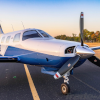09 Dec 2025, 15:48 [ UTC - 5; DST ]
|

| Username Protected |
Message |
|
Username Protected
|
Post subject: SR22TN - My Transition Experience  Posted: Posted: 12 Jul 2015, 20:47 |
|
 |

|
|
 |

Joined: 11/20/12
Posts: 713
Post Likes: +127
Location: Cedar Rapids, IA (CID)
Aircraft: 2008 Cirrus SR22TN
|
|
|
I’ve been studying Cirrus SR22’s for a while and finally pulled the trigger last month on a 2008 G3 Turbo Normalized with AC and Built in Oxygen. I knew I was giving up a lot of useful load moving from my S35, but given my typical flying needs this was not a big concern of mine.
I focused my search on a G3 for a couple of reasons. First, the wing on the G3 has a carbon fiber spar, upped the available fuel to 92 gallons and expanded TKS capacity. Additionally, the G3’s were equipped with WAAS 430 units, whereas the G2 often had non-WAAS units; the WAAS upgrade for a G2 could approach 17K when done properly; fiberglass work on the second unit can be pretty expensive along with possible Avidyne updates.
Also, my S35 was equipped with a Garmin 430W, S-Tec55 and dual Aspen, so I was expecting the transition to be pretty simple. It was.
My first flight was from Arlington, TX back to Iowa with an instructor, who owns/operates the Certified Cirrus Service facility in Pella IA (Classic Aviation). It was a non-stop trip, and we had to stay low, because of a popped circuit that made the Oxygen system unavailable. The trip was uneventful. On this cross country, I get pretty familiar with the Avidyne/Garmin/S-Tec interfaces and buttonology. This was not a big change for me, but I could see a big learning curve had my Bo only had a six-pack rather than Aspen. We dodged some storms and flew the trip at 11,000 feet, except for a 25 minute jump to 13,000 to get above some build-ups. We went non-stop to Cedar Rapids, and my first surprise was the sight picture for the landing and flare at KCID; this is pretty different. Shane then took the plane back to Pella for pre-buy, repair of found squawks and annual.
I did my Cirrus Transition training last Wednesday, which included a high-altitude leg, up to 22K, a whole lot of landings (normal, partial flaps, no flaps, short field, etc…). We really focused on pegging the speeds, of 100kias (downwind), 90kias (base) and 80kias (short final) and the landings turned out to be a non-issue. Weather was very calm, so I have not any real cross-winds, but that will come in time; I’m expecting this to be a bit more challenging than with the S35.
Today, I went out for another couple of hours of Solo work and practiced some flight maneuvers, worked on landings, ran a practice RNAV and then on my way back to Cedar Rapids, flew another RNAV in IMC. I hand flew the approach, following the Flight Director, mostly in the clouds on the approach, breaking out at a safe margin of 1,000 ft AGL; very easy to hand fly with the instruments. I’m keeping my minimums high until I get more time in this plane.
I’ve made a number of observations as it relates to this plane and the transition, which I’ve put into various categories below.
Hangar Space
• One of my key concerns was getting the Cirrus safely in and out of my 40’ hangar. Reading on COPA, many pilots had said this was a non-issue after a few times.
• The 38’4” wing, leaves very little margin of safety in a 40’ hangar. The Bo, with the 33’5” wing gave me a lot more comfort.
• Today, I taped off and painted exactly where the main’s for the Cirrus need to enter the hangar and their final parking spots. This will help a great deal.
• I’ve got a Sidewinder coming, which will help a great deal; this is a completely different design, and I’ve seen some issues with other pilots. In my conversations with Redline, I’m optimistic it will work well; they have assured me if there is an issue, they will take care of me.
Training
• The online CPPP training is pretty comprehensive and as I understand it is modeled after the BPPP program. I took the BPPP program last fall and flew with Tom Turner and can’t say enough about this program. It simplified the way I flew the Bo in instrument conditions completely, which greatly increased my confidence and safety in instrument flying.
Technology
• This plane is loaded with technology and the size of the Avidyne Displays is a big improvement over the Aspen. I was worried about how comfortable and how much I relied on my Foreflight and Stratus II, which I brought on today’s flight as a backup, but never touched it.
• The size of the PFD is great and getting used to the information was pretty easy. I like the trend information that is show for Airspeed and Altitude, which shows you were you will be in six seconds if you follow whatever changes you have initiated.
• Once on autopilot, the PFD controls most aspects of flight, which was a little different from my Aspen set-up. The Altitude pre-select is a nice feature, but the altitude alert that I had on the Aspen was also nice.
• The flight director is great. I know this is widely available and I really like it.
Side Yoke
• Pilots have told me this would take about 5 minutes to get used to, and they were right. The plane is very responsive and I find that I really like the side yoke. The electric trim is also very responsive and I find that I can hand-fly with minor trim adjustments while in cruise.
• When hand-flying the plane is very stable. It seemed that in my Bo, when I would look down to change something in the cockpit, I needed a bit more adjustment when I looked back up.
Safety
• The seat harnesses are very nice. In turbulence, which I believe the Cirrus handles very well, the Harness holds you in snug, without being a bother.
• The TKS, Stormscope, Skywatch, TAWS, XM Satellite are all features available on other planes, but I really like having them all in this plane.
• The Chute is a nice-to-have out when all else fails.
TN
• TN, as well as built in Oxygen, was a must have on my next plane. Fuel management could not be easier; full forward mixture on all take offs, then lean to 17.5 at cruise. On the return flight, we noticed higher CHT’s so continued to lean down to 16.5 and then 16 just to see the impact; it ran very smoothly this far lean of peak.
_________________
Joe Kirby
"Without a plan, everything makes sense."
|
|
| Top |
|
|
Username Protected
|
Post subject: Re: SR22TN - My Transition Experience  Posted: Posted: 12 Jul 2015, 21:16 |
|
 |

|
|
 |

Joined: 11/21/09
Posts: 12489
Post Likes: +17140
Location: Albany, TX
Aircraft: Prior SR22T,V35B,182
|
|
Welcome to the club, Joe!  Like Tony, I took the 40 hour IFR transition course and thought it well worth the time.
|
|
| Top |
|
|
Username Protected
|
Post subject: Re: SR22TN - My Transition Experience  Posted: Posted: 12 Jul 2015, 21:29 |
|
 |

|
|
 |

Joined: 05/13/14
Posts: 9162
Post Likes: +7682
Location: Central Texas (KTPL)
Aircraft: PA-46-310P
|
|
Great write-up Joe....congratulations!  If the G3 has a carbon fiber spar, does that mean earlier models didn't? If not, what kind of spar do they have?
|
|
| Top |
|
|
Username Protected
|
Post subject: Re: SR22TN - My Transition Experience  Posted: Posted: 12 Jul 2015, 21:44 |
|
 |

|
|
 |


Joined: 08/20/09
Posts: 2666
Post Likes: +2245
Company: Jcrane, Inc.
Location: KVES Greenville, OH
Aircraft: C441, RV7A
|
|
Congrats Joe! I'm glad you found "the one". The only complaint I have with Cirrus is that it's just too easy  after 50 hrs or so it's like driving your car. If only they offered a cabin class 6+ seat twin or turbine single...
_________________
Jack
N441M N107XX
|
|
| Top |
|
|
Username Protected
|
Post subject: Re: SR22TN - My Transition Experience  Posted: Posted: 12 Jul 2015, 23:34 |
|
 |

|
|
 |

Joined: 11/20/12
Posts: 713
Post Likes: +127
Location: Cedar Rapids, IA (CID)
Aircraft: 2008 Cirrus SR22TN
|
|
Username Protected wrote: Great write-up Joe....congratulations!  If the G3 has a carbon fiber spar, does that mean earlier models didn't? If not, what kind of spar do they have? Tony - From what I have read, the G2 spar was made of some type of fiberglass. Below is an AOPA article that discusses the difference. http://www.aopa.org/News-and-Video/All-News/2008/January/1/Cirrus-SR22-G3-New-set-of-wings
_________________
Joe Kirby
"Without a plan, everything makes sense."
|
|
| Top |
|
|
Username Protected
|
Post subject: Re: SR22TN - My Transition Experience  Posted: Posted: 13 Jul 2015, 11:13 |
|
 |

|
|
 |

Joined: 11/20/12
Posts: 713
Post Likes: +127
Location: Cedar Rapids, IA (CID)
Aircraft: 2008 Cirrus SR22TN
|
|
Username Protected wrote: Joe,
be honest, which do you prefer? Michael, The Cirrus. But to be fair they are completely different airplanes. The comfort and the capabilities of the Cirrus comes with a price tag. The S35 is an incredibly efficient and quality airplane. Joe
_________________
Joe Kirby
"Without a plan, everything makes sense."
|
|
| Top |
|

|
You cannot post new topics in this forum
You cannot reply to topics in this forum
You cannot edit your posts in this forum
You cannot delete your posts in this forum
You cannot post attachments in this forum
|

Terms of Service | Forum FAQ | Contact Us
BeechTalk, LLC is the quintessential Beechcraft Owners & Pilots Group providing a
forum for the discussion of technical, practical, and entertaining issues relating to all Beech aircraft. These include
the Bonanza (both V-tail and straight-tail models), Baron, Debonair, Duke, Twin Bonanza, King Air, Sierra, Skipper, Sport, Sundowner,
Musketeer, Travel Air, Starship, Queen Air, BeechJet, and Premier lines of airplanes, turboprops, and turbojets.
BeechTalk, LLC is not affiliated or endorsed by the Beechcraft Corporation, its subsidiaries, or affiliates.
Beechcraft™, King Air™, and Travel Air™ are the registered trademarks of the Beechcraft Corporation.
Copyright© BeechTalk, LLC 2007-2025
|
|
|
|



